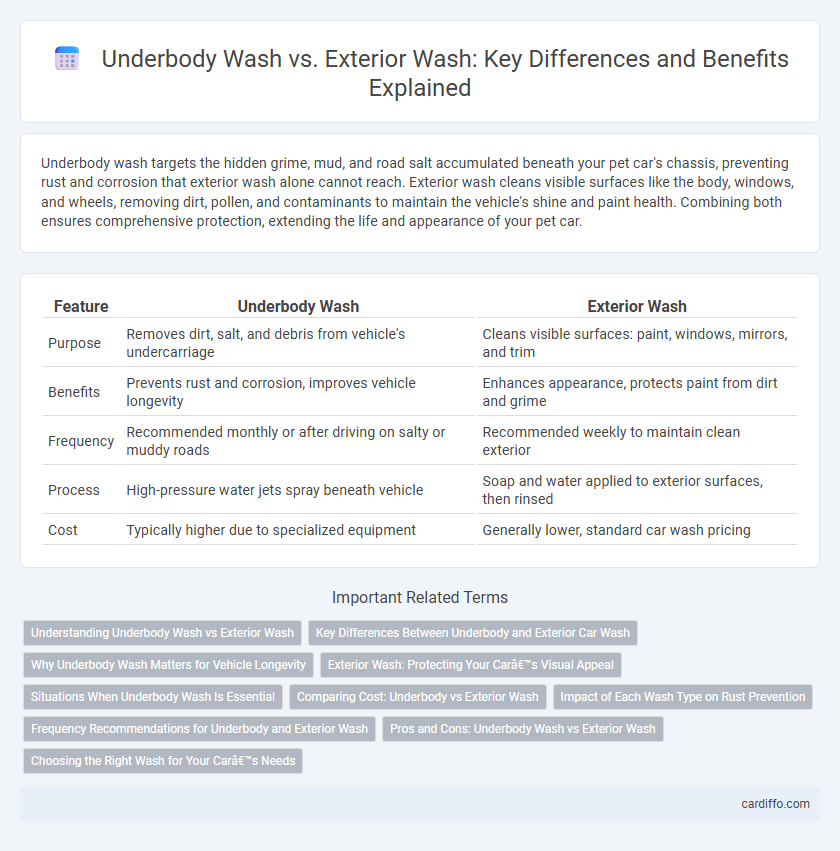Underbody wash targets the hidden grime, mud, and road salt accumulated beneath your pet car's chassis, preventing rust and corrosion that exterior wash alone cannot reach. Exterior wash cleans visible surfaces like the body, windows, and wheels, removing dirt, pollen, and contaminants to maintain the vehicle's shine and paint health. Combining both ensures comprehensive protection, extending the life and appearance of your pet car.
Table of Comparison
| Feature | Underbody Wash | Exterior Wash |
|---|---|---|
| Purpose | Removes dirt, salt, and debris from vehicle's undercarriage | Cleans visible surfaces: paint, windows, mirrors, and trim |
| Benefits | Prevents rust and corrosion, improves vehicle longevity | Enhances appearance, protects paint from dirt and grime |
| Frequency | Recommended monthly or after driving on salty or muddy roads | Recommended weekly to maintain clean exterior |
| Process | High-pressure water jets spray beneath vehicle | Soap and water applied to exterior surfaces, then rinsed |
| Cost | Typically higher due to specialized equipment | Generally lower, standard car wash pricing |
Understanding Underbody Wash vs Exterior Wash
Underbody wash targets the vehicle's chassis, suspension, and wheel wells to remove dirt, salt, and debris that contribute to rust and corrosion, especially in regions with harsh winters. Exterior wash focuses on cleaning the visible surfaces such as the paint, windows, and mirrors to maintain aesthetic appeal and protect the clear coat from contaminants. Understanding the difference ensures proper vehicle maintenance by addressing hidden damage risks with underbody wash and enhancing appearance with exterior wash.
Key Differences Between Underbody and Exterior Car Wash
Underbody wash targets the vehicle's underside, removing dirt, salt, and corrosive materials that cause rust and damage to vital components, while exterior wash focuses on cleaning the visible surfaces like paint, windows, and wheels. Underbody washing often involves high-pressure water jets specifically designed to reach suspension parts and the frame, whereas exterior wash uses foam, soap, and gentle brushes to preserve the car's finish. Understanding these key differences helps maintain both the aesthetic appeal and structural integrity of the vehicle.
Why Underbody Wash Matters for Vehicle Longevity
An underbody wash targets dirt, salt, and grime buildup underneath a vehicle, preventing rust and corrosion that can severely damage essential components like the frame, suspension, and exhaust system. Exterior washes clean visible surfaces like paint, windows, and mirrors but do not reach hidden areas prone to accumulation of harmful debris. Regular underbody washing is crucial in extending vehicle longevity, especially in regions with road salt or off-road driving conditions.
Exterior Wash: Protecting Your Car’s Visual Appeal
Exterior wash focuses on removing dirt, grime, and contaminants from a car's surface, preserving the paint's integrity and enhancing its visual appeal. Unlike underbody wash, which targets the vehicle's underside to prevent rust and corrosion, exterior wash maintains the car's shine and prevents damage from UV rays and environmental pollutants. Regular exterior washing helps protect clear coats and paint finishes, ensuring your vehicle looks clean and well-maintained.
Situations When Underbody Wash Is Essential
An underbody wash is essential after driving on salty roads, muddy terrains, or during winter months to prevent corrosion and buildup of debris in hard-to-reach areas. Unlike a standard exterior wash that cleans visible surfaces, an underbody wash targets the chassis, wheel wells, and suspension components where rust and damage commonly initiate. Regular underbody cleaning extends vehicle lifespan, improves safety, and maintains optimal performance by removing harmful contaminants.
Comparing Cost: Underbody vs Exterior Wash
Underbody washes typically cost more than exterior washes due to the specialized equipment and higher water pressure required to remove grime and salt from underneath the vehicle. Exterior washes are generally less expensive, focusing primarily on cleaning visible surfaces like paint, windows, and wheels, often using automated or manual processes. The cost difference reflects the complexity and thoroughness of the underbody process, which helps prevent rust and corrosion in regions with harsh weather conditions.
Impact of Each Wash Type on Rust Prevention
Underbody wash targets areas prone to rust, such as wheel wells and frame components, effectively removing salt, mud, and grime that accelerate corrosion. Exterior wash primarily cleans visible surfaces but often misses these critical rust-prone zones, offering limited protection against rust development. Regular underbody washing significantly extends vehicle lifespan by preventing rust formation in vulnerable structural parts.
Frequency Recommendations for Underbody and Exterior Wash
Underbody wash should be performed every 4 to 6 weeks, especially in regions with heavy road salt or muddy conditions to prevent rust and corrosion. Exterior wash frequency depends on environmental factors, with a general recommendation of once every 1 to 2 weeks to remove dirt, grime, and contaminants. Regular underbody cleaning extends vehicle lifespan, while consistent exterior washing maintains paint integrity and appearance.
Pros and Cons: Underbody Wash vs Exterior Wash
Underbody wash effectively removes salt, mud, and grime from the vehicle's underside, preventing rust and corrosion, which is especially beneficial in winter or off-road conditions, but it may not address visible dirt on the car's body. Exterior wash focuses on cleaning the vehicle's paint, windows, and tires, enhancing appearance and protecting the finish with wax or sealant options, though it generally ignores the undercarriage where grime accumulates. Combining both washes offers comprehensive protection, though underbody washes can be more time-consuming and may require specialized equipment compared to standard exterior washes.
Choosing the Right Wash for Your Car’s Needs
Underbody wash targets the vehicle's chassis and suspension, effectively removing road salt, mud, and debris that cause rust and corrosion, especially in regions with harsh winter conditions. Exterior wash focuses on the car's visible surfaces, eliminating dirt, grime, and pollutants to maintain paintwork and shine. Selecting the right wash depends on your car's usage environment; frequent exposure to road salts or off-road conditions necessitates an underbody wash, while regular city driving benefits more from a thorough exterior wash.
Underbody Wash vs Exterior Wash Infographic

 cardiffo.com
cardiffo.com